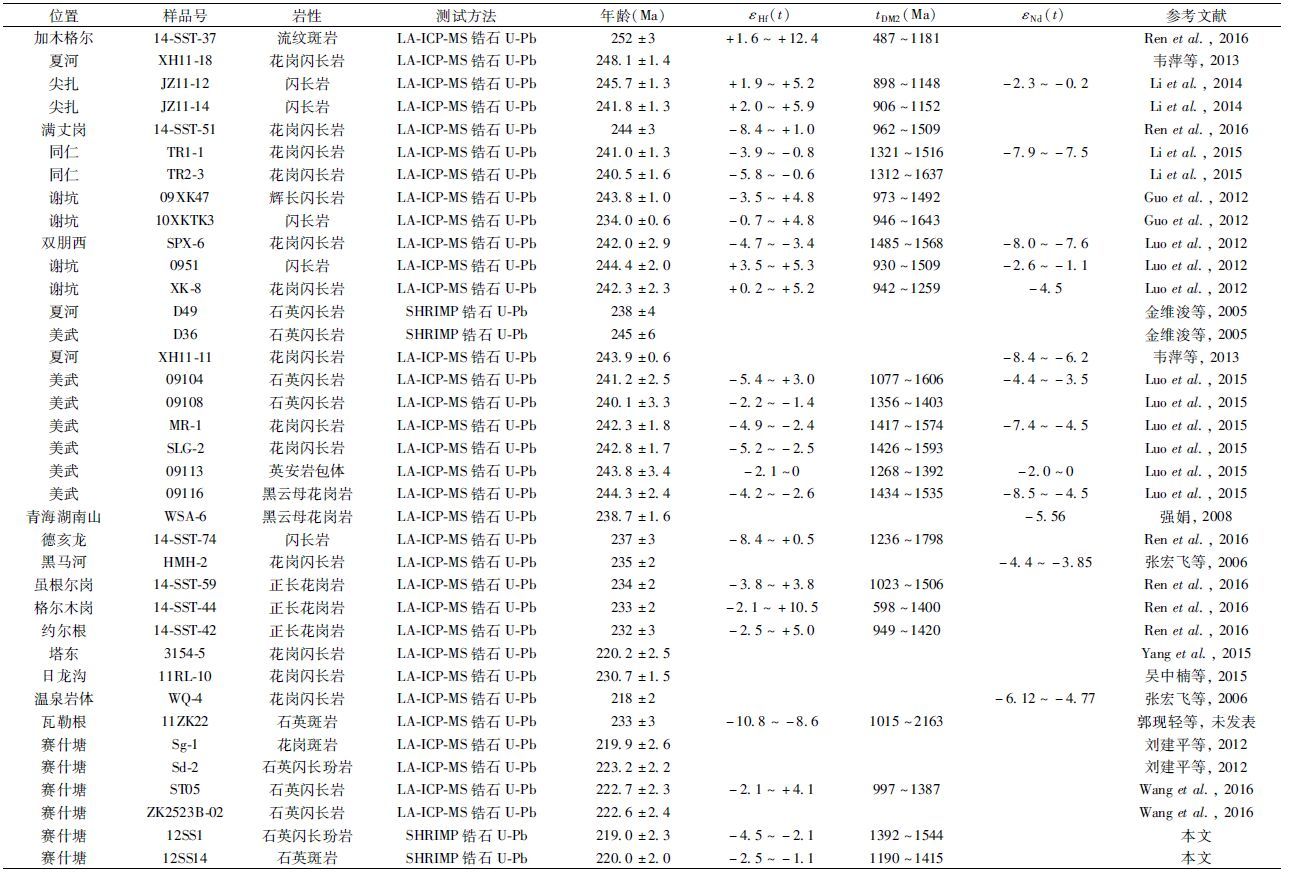2. 中国地质科学院矿产资源研究所, 北京 100037;
3. 合肥工业大学资源与环境工程学院, 合肥 230009;
4. 中国科学院大学地球科学学院, 北京 100049
2. Institute of Mineral Resources, Chinese Academy of Geological Sciences, Beijing 100037, China;
3. Department of Resources and Environment, Hefei University of Technology, Hefei 230009, China;
4. College of Earth Science, University of Chinese Academy of Sciences, Beijing 100049, China
西秦岭地处秦岭、祁连、昆仑和松潘-甘孜造山带交汇部分,在地质图上呈“楔形”插入祁连和昆仑造山带内部(图 1b; 闫臻等,2012)。区内构造-岩浆活动强烈,以分布大面积三叠纪沉积岩和岩浆岩为典型特征,同时存在大量与三叠纪岩浆作用密切相关的铜、铅、锌、金、银等矿床,如赛什塘、铜峪沟、双朋西、江里沟、谢坑等铜多金属矿床(李东生等,2009; 傅晓明等,2010; 李欢等,2010; 郭现轻等,2011; 曾小华和周宗桂,2014),加吾和瓦勒根金矿床以及夏卜浪铅锌多金属矿床(曾福基等,2009; 闫家盼等,2011; 李秀财等,2015)。这些矿床及相关岩浆作用与古特提斯洋演化具有密切成因联系(闫臻等,2012)。因此,系统研究这些岩浆岩地球化学特征、形成时代和时空变化特征可为理解古特提斯洋演化过程中深部岩浆作用过程和成矿动力学背景提供依据,同时可为区域地质找矿提供理论指导。
赛什塘铜矿床是西秦岭地区规模较大的斑岩-矽卡岩型铜矿床。前人曾从矿物学、流体包裹体、地球化学和年代学等方面对该矿床进行了大量研究(江新胜等,1996; 詹发余等,2007; 李东生等,2009; 赖健清等,2010; 刘建平等,2012; 王辉等,2015; 王军升和王玉往,2015; Wang et al., 2016; Lu et al., 2016),但对矿区花岗质岩石形成大地构造环境相对缺乏岩石学和地球化学等方面的系统研究,因此始终存在有大陆边缘弧(江新胜等,1996; 潘桂棠等,1997; 赖健清等,2010; 王军升和王玉往,2015)、同碰撞(孙延贵,2004)和后碰撞环境(詹发余等,2007; 刘建平等,2012; Wang et al., 2016)等构造环境的争议。这些不同认识严重影响了对该矿床的成因认识和区域找矿,同时也影响了对西秦岭地区中生代构造-岩浆-成矿作用与大地构造演化相互关系的合理认识。
本文在对赛什塘铜矿区石英闪长玢岩和石英斑岩开展岩石学、岩石地球化学以及锆石SHRIMP测年和Lu-Hf同位素综合研究基础上,结合前人对西秦岭三叠纪花岗岩以及区域地质构造演化的研究成果,综合分析赛什塘铜矿区内三叠纪岩浆作用形成大地构造背景,并探讨岩浆源区和岩浆演化过程。
1 地质背景赛什塘铜矿床位于青海省兴海县境内,地处西秦岭西南端和鄂拉山岩浆带东南段(图 1b)。区域上,研究区西侧为东昆仑造山带,东侧为秦岭造山带。近年来,愈来愈多的斑岩型-矽卡岩型矿床(如赛什塘铜矿、日龙沟锡矿、铜峪沟铜矿、尕科合铜银砷矿床和拉届亥钼铜矿等)在鄂拉山三叠纪花岗岩内部及其与围岩接触带中被发现,表明该地区具有寻找斑岩-矽卡岩型铜钼、铜金等类型矿床的良好潜力,同时西秦岭西段鄂拉山地区也已发展成为青海省重要的铜多金属成矿带之一(宋治杰等,1995; 刘增铁等,2008)。
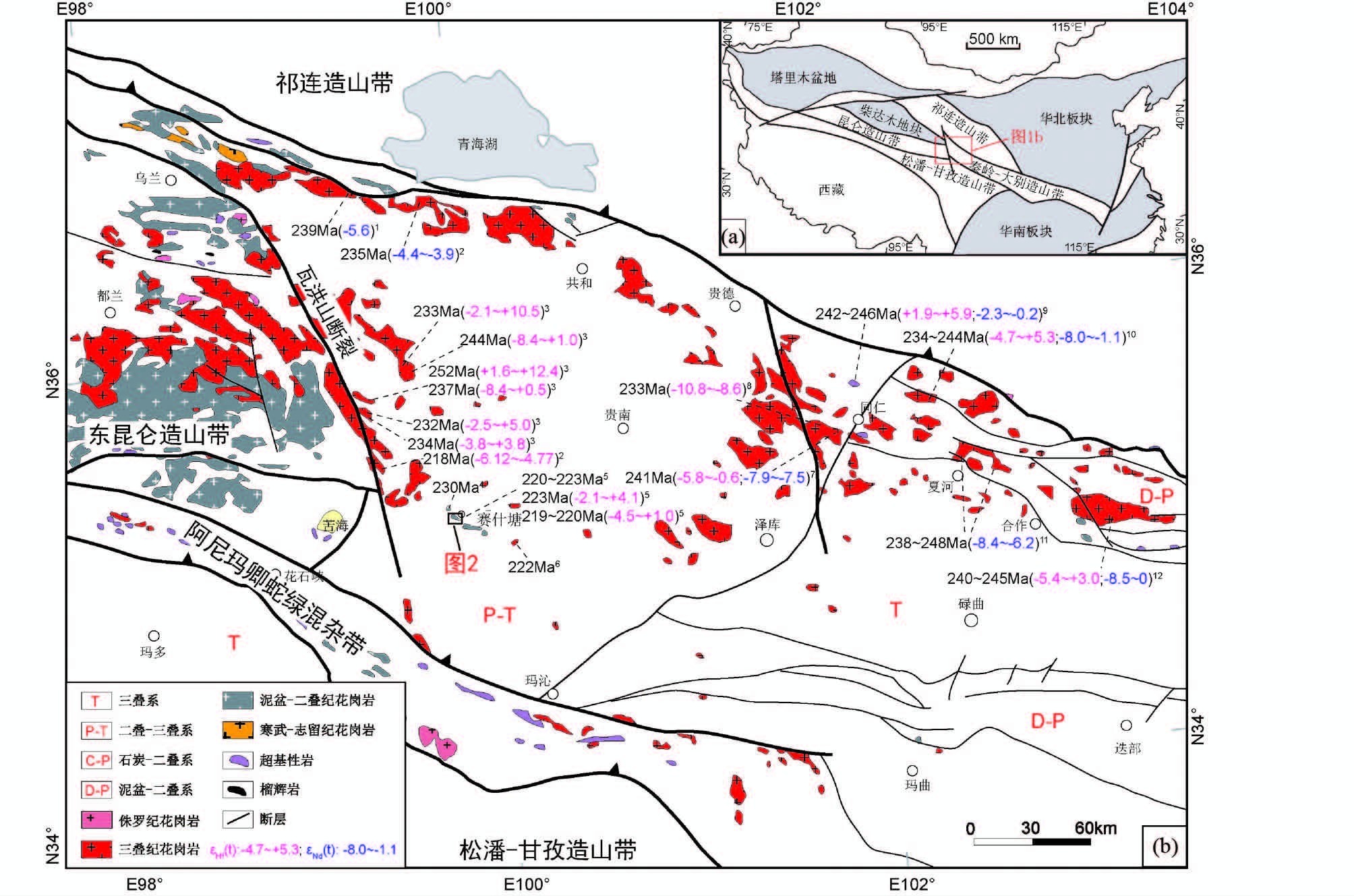
|
图 1 西秦岭及邻区地质简图(据闫臻等,2012修改)
西秦岭三叠纪花岗质岩石数据(表 5):1-青海湖南山(强娟,2008);2-黑马河和温泉(张宏飞等,2006);3-加木格尔、满丈岗、德亥龙、虽根尔岗、格尔木岗和约尔根(Ren et al., 2016);4-日龙沟(吴中楠等,2015);5-赛什塘(本文; 刘建平等,2012; Wang et al., 2016);6-塔东(Yang et al., 2015);7-同仁(Li et al., 2015);8-瓦勒根(郭现轻等,未发表数据);9-尖扎(Li et al., 2014);10-岗察(Guo et al., 2012; Luo et al., 2012);11-夏河(金维浚等,2005; 韦萍等,2013);12-美武岩体(金维浚等,2005; Luo et al., 2015) Fig. 1 Geological map of the West Qinling and adjacent areas(modified after Yan et al., 2012) Data of the granitoids in West Qinling(Table 5)are from: 1-Qinghaihunanshan(Qiang,2008); 2-Heimahe and Wenquan(Zhang et al., 2006); 3-Jiamuge’er,Manzhanggang,Dehailong,Suigen’ergang,Ge’ermugang and Yue’ergen(Ren et al., 2016); 4-Rilonggou(Wu et al., 2015); 5-Saishitang(This study; Liu et al., 2012; Wang et al., 2016); 6-Tadong(Yang et al., 2015); 7-Tongren(Li et al., 2015); 8-Walegen(Guo et al., unpublished data); 9-Jianzha(Li et al., 2014); 10-Gangcha(Guo et al., 2012; Luo et al., 2012); 11-Xiahe(Jin et al., 2005; Wei et al., 2013); 12-Meiwu intrution(Jin et al., 2005; Luo et al., 2015) |
区域上,研究区主要出露地层为三叠系,同时在局部地段零星出露少量二叠系和前寒武系。其中三叠系为中-下三叠统隆务河群,由杂砂岩、火山质杂砂岩、凝灰岩、深灰色板岩、砾岩、薄层灰岩和安山岩共同组成,发育粒序层理、波纹斜层理、水平层理和重荷模构造,为一套弧前浊流沉积(闫臻等,2014);二叠系由灰岩、角砾灰岩和砂岩构成,产 类、腕足类和有孔虫,为一套浅海相沉积组合,与三叠系之间为断层接触;前寒武系为一套中-深变质岩,主要由片麻岩、片岩和大理岩组成。
研究区内岩浆活动强烈,以三叠纪花岗质岩石为主,同时在隆务河群中可见安山岩、英安岩和流纹岩夹层。这些中酸性火山岩及相关的火山碎屑岩在鄂拉山一带大面积出露,是鄂拉山银铅锌多金属矿床和夏卜浪铜铅锌矿床的赋矿围岩。
2 研究区构造及花岗岩岩石学特征矿区内出露地层有中-下三叠统、第三系和第四系地层。中-下三叠统隆务河群由千枚岩、片岩、砂岩和大理岩组成(图 2),普遍发生强烈构造变形,局部地段经历了低绿片岩相变质作用。根据褶皱组合样式,矿区内褶皱可分为四期(张忠义等,2014),第一期和第二期褶皱是连续构造变形作用的结果,两期褶皱变形发生期间三叠纪花岗岩发生侵入并就位。断裂构造以NW、EW向断裂最为普遍。

|
图 2 赛什塘矿区地质图(据李领贵等,2012修改) Fig. 2 Geological map of Saishitang Cu deposit(modified after Li et al., 2012) |
研究区内花岗质岩石以闪长玢岩和石英闪长岩为主,其次为浅成花岗斑岩和石英斑岩岩株、岩脉(图 2、图 3)。这些侵入体表明该区三叠纪岩浆作用具有明显的多期次活动特征。根据野外相互穿插关系和产态可将这些花岗岩体分为四期(赖健清等,2010):第一期为闪长玢岩脉;第二期为中-细粒石英闪长岩、石英闪长玢岩和闪长玢岩体,它们是赛什塘岩体的主体,分布规模最大;第三期为斜长花岗斑岩,以岩株或岩脉形式产出;第四期为花岗斑岩、细粒花岗岩、石英斑岩和超浅成相次流纹岩,它们呈岩株或岩脉产出。石英斑岩岩株或岩脉周边可见隐爆角砾岩(邱风歧和董景深,1978; 田生玉,1999)。矿化主要见于花岗斑岩和石英斑岩及其与三叠系围岩接触部位,以斑岩-矽卡岩型矿化为典型特征(王辉等,2015; Lu et al., 2016)。
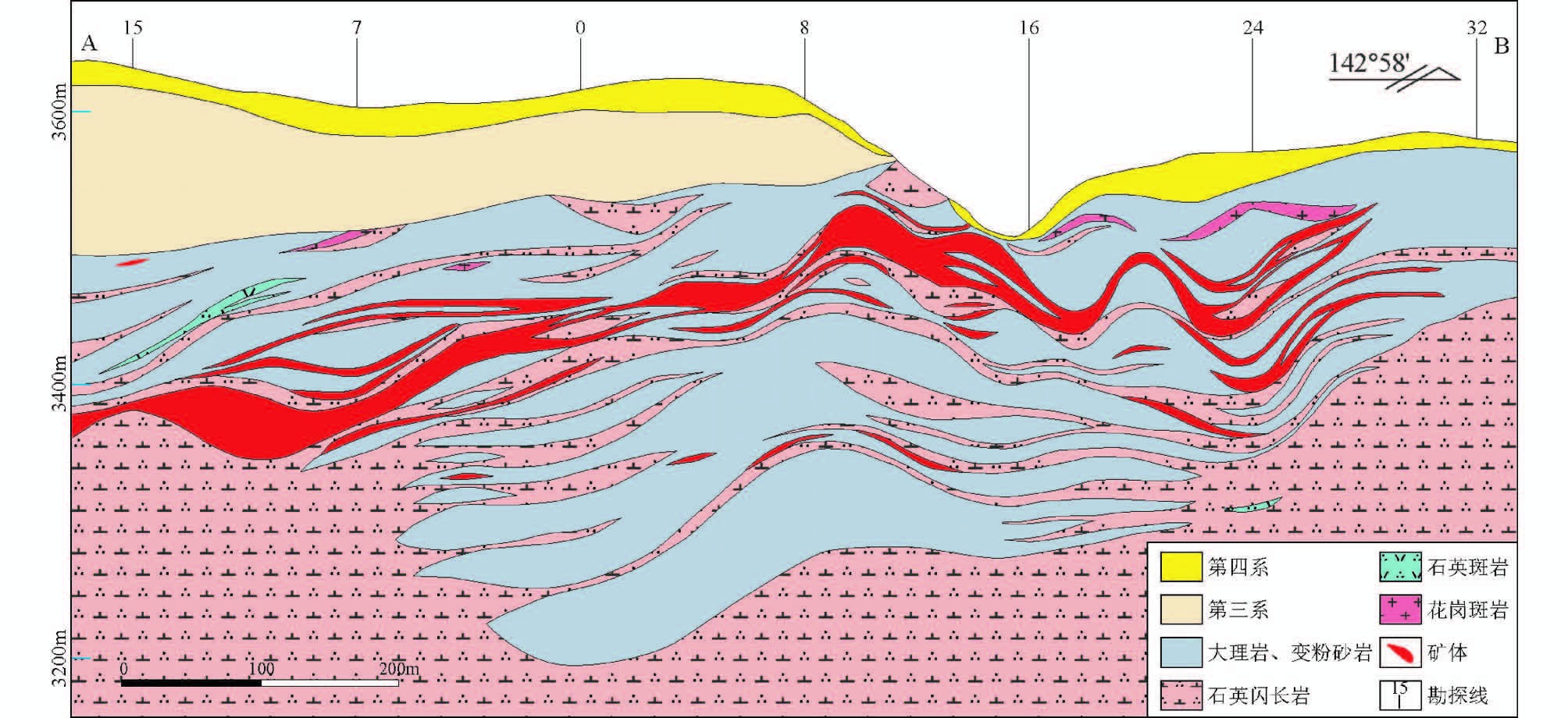
|
图 3 赛什塘矿区A-B地质纵剖面图(据李领贵等,2012修改) Fig. 3 Geological cross section A-B in Saishitang Cu deposit(modified after Li et al., 2012) |
本文重点对赛什塘主岩体石英闪长玢岩和最晚期石英斑岩岩脉进行岩石学、地球化学和同位素年代学研究,进而结合区域同时期花岗岩研究成果来讨论赛什塘岩体的岩浆源区和形成构造环境。石英闪长玢岩(GPS:35°17′35.83″N;99°47′24.52″E)在露头上呈现深灰色,致密块状构造(图 4a),具有典型半自形细粒结构(图 4b)。岩石薄片观察结果表明,斑晶主要由斜长石(25%)、石英(10%)、角闪石(10%)和黑云母(5%)组成,约占整个岩石的50%;基质主要由斜长石、石英以及少量角闪石微晶共同构成。斜长石斑晶呈半自形柱状,发育环带结构和聚片双晶,粒径为0.5~2mm,其中部分斜长石斑晶遭受较弱的绢云母化;石英斑晶为他形粒状结构,粒径为0.5~1mm;角闪石斑晶为自形柱状,粒径变化较大(0.5~3mm),可见具两组交角为约56°解理的六边形横切面以及发育一组完全解理的长柱状纵切面,部分角闪石发育简单双晶;黑云母斑晶多为半自形晶,个别晶体呈六方板状,少数黑云母边部被绿泥石取代。
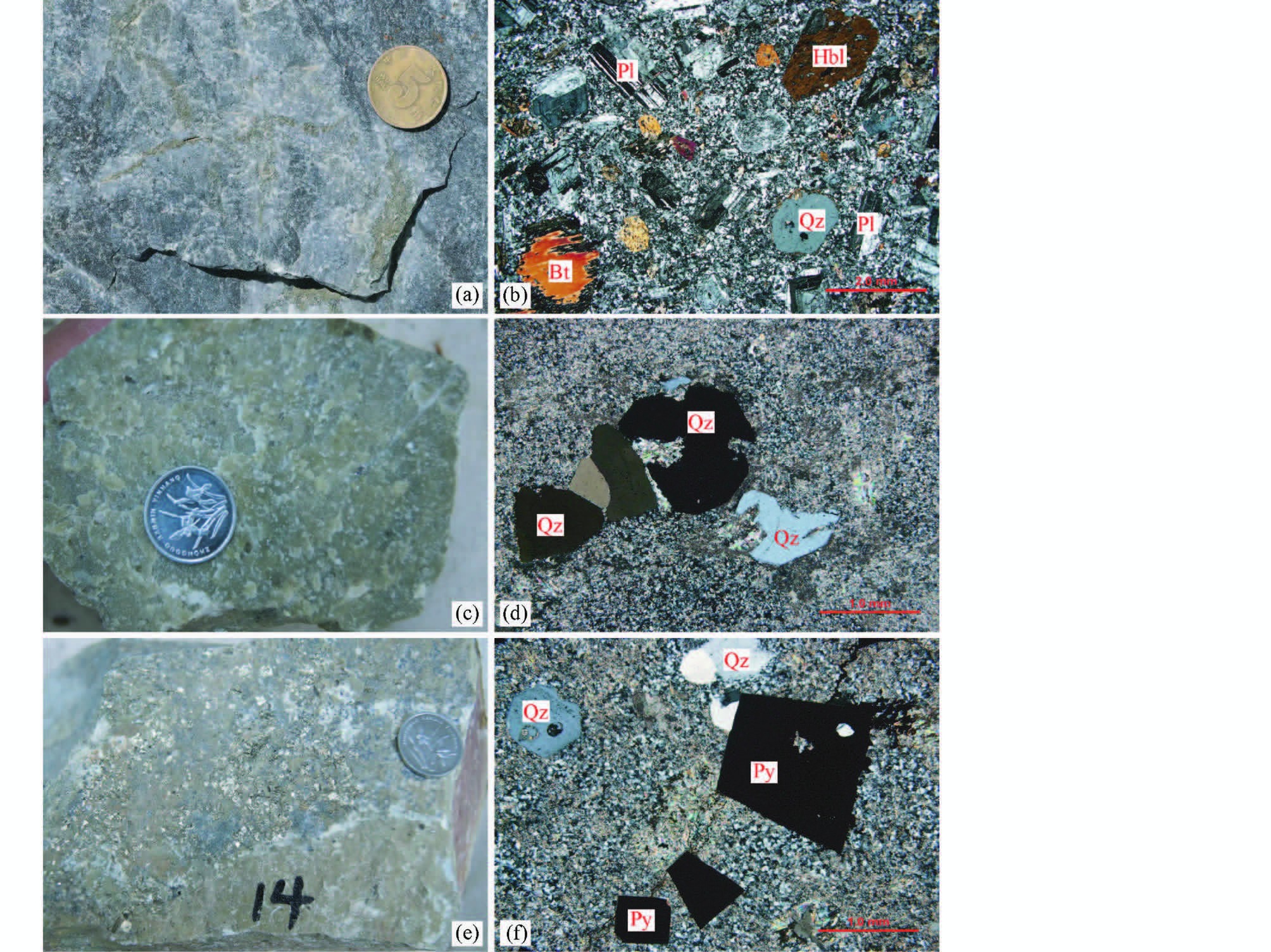
|
图 4 赛什塘矿区石英闪长玢岩和石英斑岩手标本及显微照片
(a)石英闪长玢岩由长石、石英、角闪石和黑云母组成;(b)斑状结构石英闪长玢岩,主要由长石、石英、角闪石和黑云母组成(正交光);(c)斑状结构石英斑岩;(d)斑状结构石英斑岩,发育石英斑晶(正交光);(e)含黄铁矿石英斑岩;(f)含黄铁矿石英斑岩(正交光).Bt-黑云母;Hbl-角闪石;Pl-斜长石;Py-黄铁矿;Qz-石英 Fig. 4 Hand specimen photographs and photomicrographs of quartz diorite porphyrite and quartz porphyry from the Saishitang Cu deposit (a)quartz diorite porphyrite composed of plagioclase,quartz,hornblende and biotite;(b)quartz diorite porphyrite with porphyritic texture composed of plagioclase,quartz,hornblende and biotite(crossed polars);(c)quartz porphyry with porphyritic texture;(d)quartz porphyry with porphyritic texture mainly composed of quartz phenocrysts(crossed polars);(e)pyrite-bearing quartz porphyry;(f)pyrite-bearing quartz porphyry(crossed polars). Bt-biotite; Hbl-hornblende; Pl-plagioclase; Py-pyrite; Qz-quartz |
石英斑岩(GPS:35°17′36.14″N;99°47′25.37″E)常以岩脉形式出现。露头上呈浅灰色,略带淡绿色,块状构造(图 4c),具斑状结构(图 4d)。斑晶主要为他形粒状石英,含量约为5%,粒径为0.5~1mm。基质主要由微晶石英和长石组成,部分长石蚀变为绢云母。石英斑岩中发育大量黄铁矿(图 4e),黄铁矿为自形晶(图 4f)。
3 分析方法野外采集了多件石英闪长玢岩和石英斑岩样品以用于地球化学分析,同时分别采集石英闪长玢岩(12SS1)和石英斑岩(12SS14)样品进行SHRIMP锆石U-Pb测年。在室内岩石薄片显微观察基础上,选择了蚀变相对较弱的4件石英闪长玢岩和3件石英斑岩样品对其进行了主量、微量和稀土元素地球化学成分分析,该项工作在中国地质科学院国家测试中心完成,分析结果见表 1。主量元素分析使用Phillips 4400 X-荧光光谱仪测试,分析误差小于5%;微量元素和稀土元素分析采用等离子体质谱仪(ICP-MS)来测定,分析误差小于10%。
|
|
表 1 赛什塘矿区石英闪长玢岩和石英斑岩主量元素(wt%)和微量元素(×10-6)分析结果 Table 1 Major(wt%)and trace(×10-6)elements of quartz diorite porphyrite and quartz porphyry from the Saishitang Cu deposit |
锆石分选在河北省区域地质矿产调查研究所实验室完成,锆石U-Pb测年在离子探针中心SHRIMP Ⅱ上完成,样品分析流程及原理参见宋彪等(2002)。数据处理使用Isoplot软件(Ludwig,2003),置信度为95%。
锆石原位Lu-Hf同位素分析在中国科学院地质与地球物理研究所Neptune多接收电感耦合等离子质谱仪(MC-ICPMS)和193nm激光取样系统上进行,分析时激光束直径为60μm,激光剥蚀时间约26s,分析中所用激光脉冲速率为8~10Hz,能量密度为100mJ/cm2。详细测试流程和仪器运行条件等参见Wu et al.(2006)。
4 分析结果 4.1 地球化学特征石英闪长玢岩样品SiO2含量为64.64%~67.74%,TiO2含量为0.43%~0.49%,Al2O3含量为15.14%~16.33%,MnO含量为0.03%~0.06%,MgO含量为1.25%~1.94%,Mg#为59~64,Na2O+K2O含量为6.38%~7.29%,烧失量为1.47%~3.20%。石英斑岩样品SiO2含量为71.75%~74.22%,TiO2含量较低(0.03%~0.04%),Al2O3含量为12.54%~12.82%,MnO含量为0.11%~0.15%,MgO含量较低(0.16%~0.33%),Mg#为39~68,Na2O+K2O含量较低(3.30%~3.89%),烧失量较高(5.27%~5.53%)。在K2O-SiO2图解中(图 5a),大部分石英闪长玢岩和石英斑岩样品落在高钾钙碱性系列范围内。石英闪长玢岩A/CNK<1,显示准铝质特征(图 5b);石英斑岩A/CNK变化较大为1.00~1.26,同时烧失量较高,显微观察结果显示石英斑岩中存在大量鳞片状绢云母,表明石英斑岩发生明显的蚀变作用。

|
图 5 赛什塘矿区和西秦岭花岗质岩石K2O-SiO2(a,据Rickwood,1989)和A/NK-A/CNK(b,据Maniar and Piccoli, 1989)图解
赛什塘铜矿花岗质岩石地球化学数据赖健清等,2010; 刘建平等,2012;Wang et al., 2016 Fig. 5 K2O vs. SiO2(a,after Rickwood,1989)and A/NK vs. A/CNK(b,after Maniar and Piccoli, 1989)diagrams of granitoids from the Saishitang Cu deposit and West Qinling Data of granitoids from the Saishitang Cu deposit are from Lai et al., 2010; Liu et al., 2012; Wang et al., 2016 |
在球粒陨石标准化稀土元素配分图上(图 6a),石英闪长玢岩和石英斑岩均呈右倾配分曲线。其中石英闪长玢岩稀土元素含量较高(ΣREE=131.5×10-6~175.7×10-6),轻重稀土元素分异较强烈(LREE/HREE=11.7~14.8;(La/Yb)N=15.4~22.9),具有弱的Eu负异常,δEu=0.69~0.78。相对于石英闪长玢岩,石英斑岩稀土元素含量总量较低为78.32×10-6~93.20×10-6,轻、重稀土元素分异较弱,LREE/HREE=7.50~8.12,(La/Yb)N=8.50~8.70,而Eu负异常较为显著,δEu=0.28~0.43。在原始地幔标准化微量元素蛛网图上(图 6b),石英闪长玢岩和石英斑岩具有相似的微量元素特征,均富集大离子亲石元素Cs、Rb、K和Pb,亏损Nb、Ta和Ti等高场强元素。
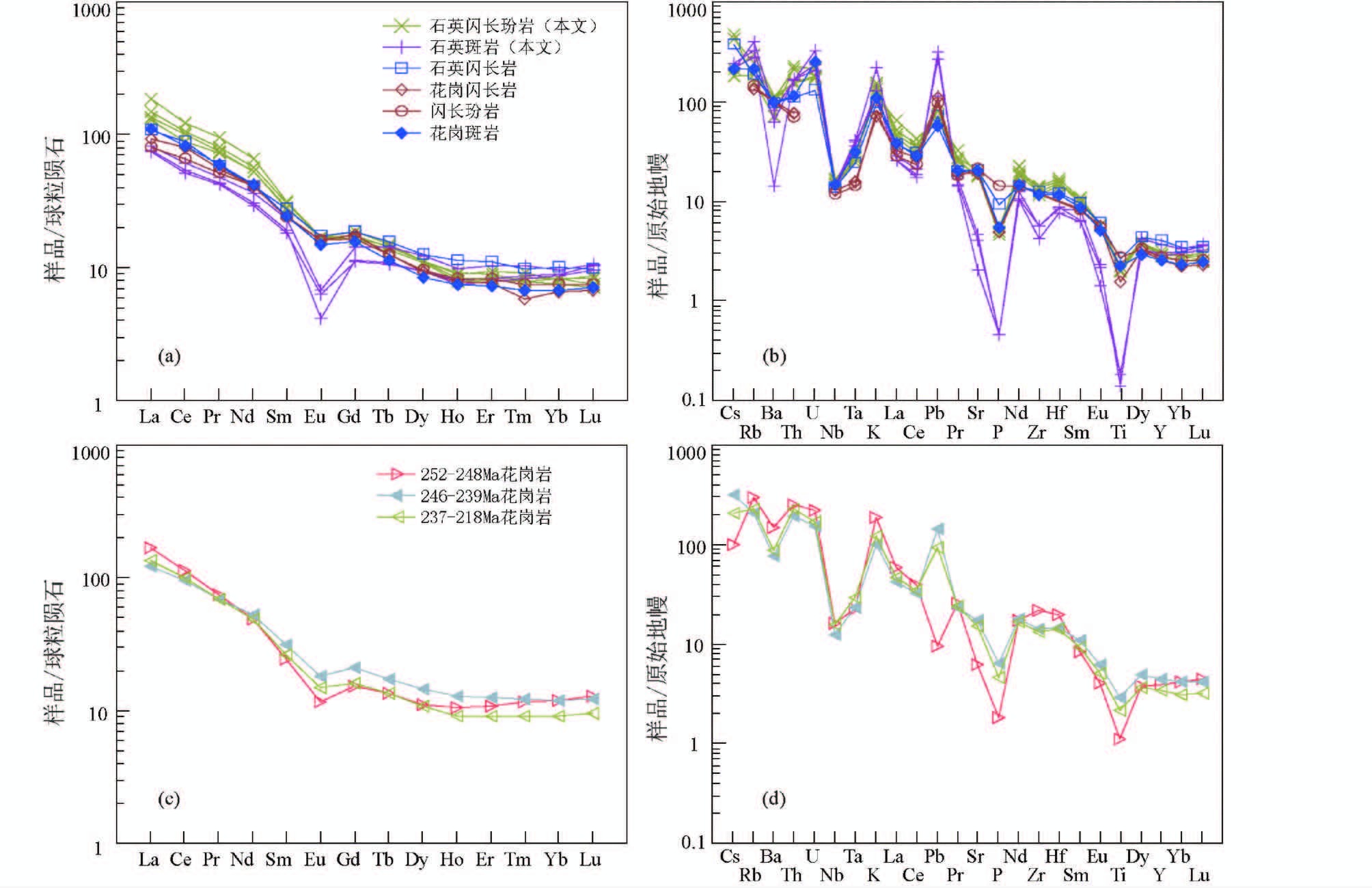
|
图 6 赛什塘矿区和西秦岭花岗质岩石球粒陨石标准化稀土元素和原始地幔标准化微量元素配分模式图(标准化值据Sun and Mcdonough, 1989)
图中曲线为相同类型岩石或同时代花岗岩稀土和微量元素含量的平均值 Fig. 6 Chondrite-normalized REE patterns and primitive mantle-normalized trace element patterns of the granitoids from the Saishitang Cu deposit and West Qinling(normalization values are Sun and Mcdonough, 1989) The abundance of the REE and trace elements of same lithology or coeval granites was averaged in the plot |
石英闪长玢岩和石英斑岩与矿区其他花岗质岩石和西秦岭三叠纪花岗岩相比,均呈现富集Cs、Rb等大离子亲石元素以及亏损Nb、Ta、Zr和Ti等高场强元素的特征(图 6),表明西秦岭三叠纪花岗岩与古特提斯洋俯冲作用密切相关。
4.2 锆石SHRIMP U-Pb年龄石英闪长玢岩样品12SS1中锆石总体为无色透明,颗粒较大且形态完整,多为自形长柱状,长度为100~350μm,长/宽比>1.5,多数发育包裹体。阴极发光(CL)图像(图 7a)显示,锆石呈灰白色-灰黑色,具有清晰的岩浆震荡环带,呈现出典型岩浆锆石特征。石英斑岩样品12SS14锆石颗粒相对较小,多呈自形柱状和半自形短柱状,长为80~150μm,长/宽比约为2,锆石表面干净,包裹体不发育。阴极发光(CL)图像(图 7b)上为深灰色,岩浆韵律环带发育。

|
图 7 赛什塘矿区石英闪长玢岩、石英斑岩锆石阴极发光图像和SHRIMP U-Pb年龄谐和图 Fig. 7 Cathodoluminescence(CL)images and SHRIMP U-Pb concordia diagram of zircons from quartz diorite porphyrite and quartz porphyry in the Saishitang Cu deposit |
本文对石英闪长玢岩12SS1样品中13颗锆石和石英斑岩12SS14样品中10颗锆石分别进行了SHRIMP测年,测试结果见表 2。石英闪长玢岩中锆石U和Th含量变化较大,分别为97×10-6~983×10-6和45×10-6~214×10-6,Th/U比值为0.13~0.57。13颗锆石的206Pb/238U年龄介于210.6~226.9Ma之间,并且均落在U-Pb谐和线上,其206Pb/238U加权平均年龄为219.0±2.3Ma(n=13,MSWD=0.97)(图 7a),该年龄代表了岩浆结晶年龄。
|
|
表 2 赛什塘矿区石英闪长玢岩(12SS1)和石英斑岩(12SS14)锆石SHRIMP U-Pb测年数据 Table 2 Zircon SHRIMP U-Pb data of quartz diorite porphyrite(12SS1)and quartz porphyry(12SS14)from the Saishitang Cu deposit |
石英斑岩中9颗锆石206Pb/238U年龄介于215.6~223.2Ma之间,其U和Th含量与石英闪长玢岩基本一致,分别为196×10-6~1047×10-6和29×10-6~289×10-6,Th/U比值为0.15~0.64,这些锆石均落在U-Pb谐和线上或附近,其206Pb/238U加权平均年龄为220.0±2.0Ma(n=9,MSWD=2.8)(图 7b),该年龄代表石英斑岩的形成时代。另外1颗继承性锆石(点10.1)U含量为327×10-6,Th含量为220×10-6,Th/U比值较高为0.67,其206Pb/238U年龄为454.0±3.1Ma。
4.3 锆石Lu-Hf同位素石英闪长玢岩和石英斑岩中23颗岩浆锆石和继承性锆石原位Lu-Hf同位素分析结果见表 3,εHf(t)值以锆石206Pb/238U表面年龄计算所得。
|
|
表 3 赛什塘矿区石英闪长玢岩(12SS1)和石英斑岩(12SS14)锆石原位Lu-Hf同位素分析结果 Table 3 Zircon Lu-Hf isotope data of quartz diorite porphyrite(12SS1)and quartz porphyry(12SS14)from the Saishitang Cu deposit |
锆石原位Lu-Hf同位素分析结果显示(表 3、图 8),石英闪长玢岩中13颗锆石176Lu/177Hf比值为0.000413~0.001025,176Hf/177Hf比值为0.282509~0.282580,εHf(t)值均为负值,变化于-4.5~-2.1。一阶段模式年龄(tDM1)变化于942~1043Ma,二阶段模式年龄(tDM2)变化于1392~1544Ma。
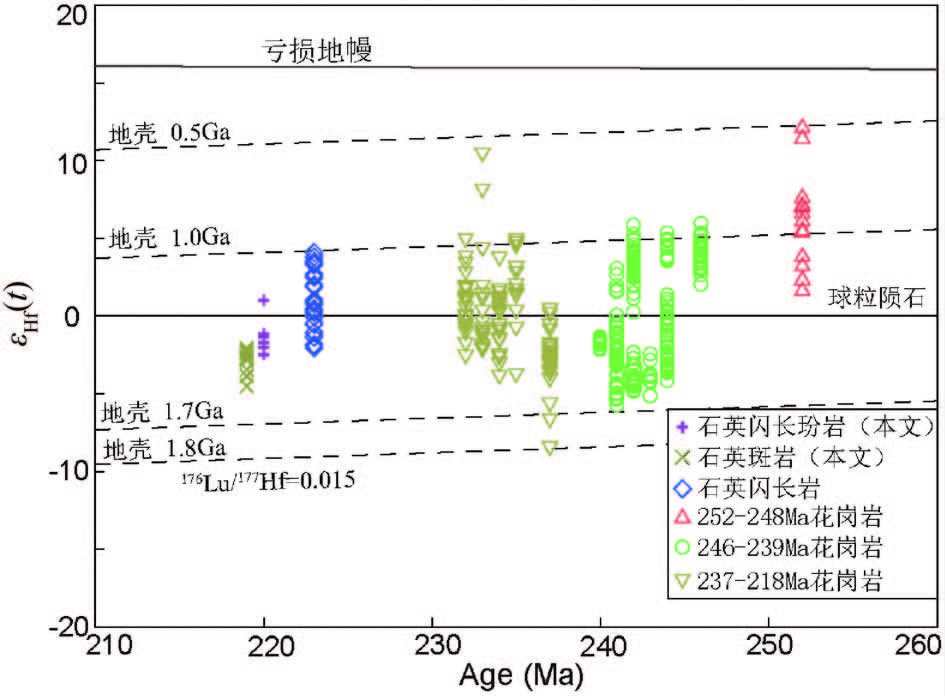
|
图 8 赛什塘矿区和西秦岭花岗质岩石锆石εHf(t)-Age图解 Fig. 8 εHf(t)versus zircon U-Pb age of the granitoids from the Saishitang Cu deposit and West Qinling |
石英斑岩中9颗三叠纪(216~223Ma)岩浆锆石176Lu/177Hf比值为0.000828~0.002344,176Hf/177Hf比值为0.282569~0.282674,除测点12SS14-4.1的εHf(t)为+1.0,其它锆石εHf(t)介于-2.5~-1.1。一阶段模式年龄(tDM1)变化于848~991Ma,二阶段模式年龄(tDM2)变化于1190~1415Ma。继承性锆石(454Ma)176Lu/177Hf比值为0.001661,176Hf/177Hf比值为0.282296,εHf(t)为-7.4,一阶段模式年龄(tDM1)和二阶段模式年龄(tDM2)分别为1375Ma和1905Ma。
5 讨论 5.1 岩石成因赛什塘铜矿区花岗质岩石与西秦岭252~218Ma花岗岩总体属于准铝质和弱过铝质钙碱性-高钾钙碱性岩石(图 5),具有高钠(Na2O=1.66%~3.94%)低磷(大部分P2O5<0.20%;表 4)的地球化学特征。除部分样品外,赛什塘铜矿区花岗质岩石样品和西秦岭同时期花岗岩A/CNK<1.1(表 4),说明这些三叠纪花岗质岩石总体表现为I型花岗岩(图 5b)。这些花岗质岩石P2O5与SiO2也呈现出与I型花岗岩一致的负相关性(图 9)。在矿物组合上,这些花岗岩含有大量黑云母和角闪石(图 4b),未见白云母、石榴石和堇青石等过铝质矿物。这些特征进一步表明,赛什塘铜矿床矿区花岗质岩石属于I型花岗岩(Chappell and White, 1992)。
|
|
表 4 赛什塘矿区花岗质岩石地球化学特征对比 Table 4 Comparison of geochemical characteristics of the granitoids from the Saishitang Cu deposit |
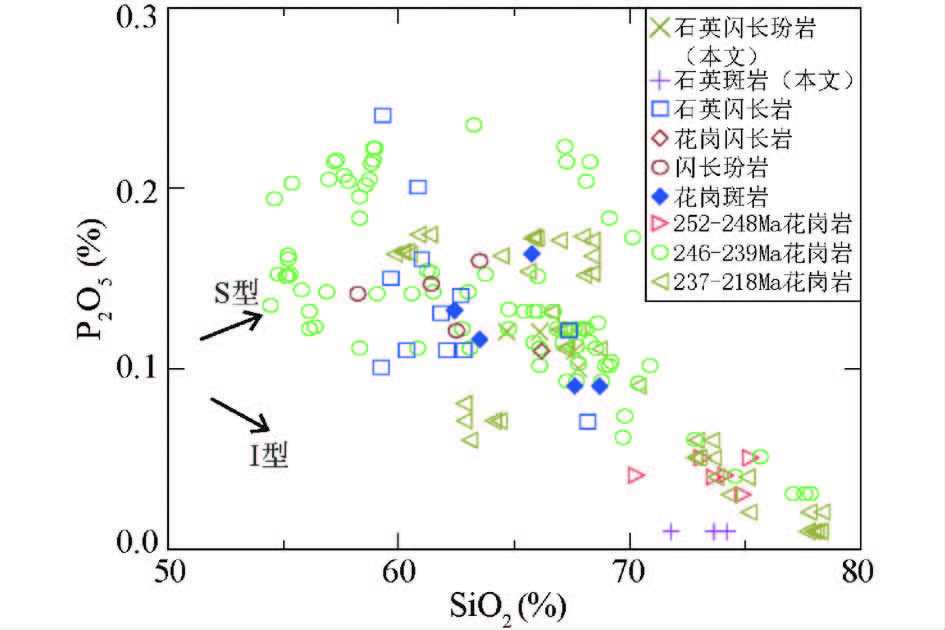
|
图 9 赛什塘矿区和西秦岭花岗质岩石SiO2-P2O5图解(据Chappell and White, 1992) Fig. 9 SiO2 vs. P2O5 diagram of the granitoids from Saishitang Cu deposit and West Qinling(after Chappell and White, 1992) |
在球粒陨石标准化稀土配分曲线和原始地幔标准化微量元素蛛网图上,赛什塘铜矿区不同类型花岗质岩石具有相似的微量元素地球化学特征(图 6)。它们均呈现右倾稀土配分曲线模式,LREE/HREE为6.39~15.7,(La/Yb)N为5.61~34.5(表 4),且富集大离子亲石元素,亏损Nb、Ta和Ti等高场强元素。同时,这些岩石具有相似的矿物组成、锆石U-Pb年龄及Lu-Hf同位素组成。这些特征共同表明,赛什塘铜矿区不同类型花岗质岩石是同源岩浆产物。
在La-La/Sm图解中(图 10a),赛什塘铜矿区与西秦岭252~218Ma花岗质岩石均表现出明显的正相关性;在Th-Th/Nd图解(图 10b)中,这些花岗质岩石呈正相关性且沿一条倾斜直线分布。这些基本特征说明,赛什塘铜矿区不同类型花岗质岩石岩浆在形成过程中经历了部分熔融作用(Schiano et al., 2010)。赛什塘铜矿区三叠纪花岗质岩石组合及其相互关系表明三叠纪岩浆具有由早期中性岩浆向晚期酸性岩浆演化特征,同时这些岩石的稀土元素配分曲线也呈现出逐渐变陡且重稀土含量逐渐降低特征(赖健清等,2010),总体显示出其岩浆结晶分异作用逐渐增强特征。与花岗闪长岩和石英闪长岩相比,石英斑岩Eu、Sr、P及Ti负异常更明显(图 6b),这进一步反映了长石、磷灰石和钛铁矿等矿物的分离结晶作用。此外,石英斑岩具有较低的ΣREE(78.3×10-6~93.2×10-6)含量和Zr/Hf(19.7~24.6)、Nb/Ta(5.8~6.4)比值以及高Rb/Sr(2.2~4.1)比值,明显区别于其它中酸性侵入岩相同元素比值(分别为76.1×10-6~175.7×10-6,30.1~41.3,5.6~21.0,0.1~0.5; 表 4)。这些微量元素含量和相似地球化学性质元素比值变化表明,石英斑岩是由岩浆经历高度分离结晶作用形成的(Blevin and Chappell, 1995; Dostal and Chatterjee, 2000)。

|
图 10 赛什塘矿区和西秦岭花岗质岩石La-La/Sm(a)和Th-Th/Nd(b,据Schiano et al., 2010)图解 Fig. 10 La vs. La/Sm(a)and Th vs. Th/Nd(b,after Schiano et al., 2010)diagrams of the granitoids from the Saishitang Cu deposit and West Qinling |
赛什塘铜矿区花岗岩呈现出明显的Nb、Ta、P、Ti亏损以及Cs、Rb、Th、K、Pb富集地球化学特征,表明其岩浆属于典型的壳源岩浆(Chappell and White, 1992)。在Nb-Nb/Th图解(图 11a)中,赛什塘花岗质岩石样品和西秦岭252~218Ma花岗岩样品主要落入靠近大陆地壳而远离原始地幔和MORB区域,与火山弧岩石样品范围基本相一致。赛什塘花岗质岩石的Th/Nb值为0.33~1.71(表 4),矿区花岗岩与西秦岭252~218Ma花岗岩在Ta/Yb-Th/Yb图解中全部均落在Th/Nb=1趋势线附近)且靠近大陆平均地壳(图 11b)。这些事实表明,赛什塘矿区花岗质岩石和西秦岭三叠纪花岗岩是由壳源岩浆形成的。

|
图 11 赛什塘矿区和西秦岭花岗质岩石Nb-Nb/Th(a)和Nb/Y-Th/Y(b,据Boztuğ et al., 2007)图解
原始地幔数据引自Hofmann,1988; 大陆地壳、弧火山岩、MORB和OIB数据引自Schmidberger and Hegner, 1999 Fig. 11 Nb vs. Nb/Th(a)and Nb/Y vs. Th/Y(b,after Boztuğ et al., 2007)diagrams of the granitoids from the Saishitang Cu deposit and West Qinling Primitive mantle after Hofmann,1988; continental crust,MORB,OIB and arc volcanics compositions after Schmidberger and Hegner, 1999 |
西秦岭地区248~242Ma花岗岩发育大量地幔来源镁铁质包体和英安岩包体(韦萍等,2013; Luo et al., 2015),而218Ma花岗岩含少量闪长质包体(张宏飞等,2006)。刘建平等(2012)曾报道赛什塘矿区岩体中含有丰富的包体但缺乏包体类型记录。这些包体的存在暗示了岩浆曾发生过混合作用。赛什塘矿区大部分花岗质岩石样品具有较高Mg#值(44~64; 表 4),这与幔源物质加入形成的岩石Mg#值(>40; Rapp and Watson, 1995)相一致。这些特征表明,赛什塘花岗质岩体与西秦岭地区同时代花岗岩的岩浆来源于被地幔混染的地壳(Smithies and Champion, 2000),并且随着幔源岩浆成分的增加,西秦岭三叠纪花岗岩锆石εHf(t)值和全岩εNd(t)值逐渐升高(图 8、图 12、表 5)。赛什塘铜矿区石英闪长玢岩和石英斑岩锆石Lu-Hf同位素组成变化较大,εHf(t)为-4.5~+1.0且以负值为主(图 8b),锆石二阶段模式年龄为1190~1544Ma;石英闪长岩εHf(t)为-2.05~+4.87,锆石二阶段模式年龄为997~1327Ma(Wang et al., 2016),它们与西秦岭其它三叠纪花岗岩具有相似的εHf(t)和锆石二阶段模式年龄(总体介于1.0~1.7Ga; 表 5)。这些三叠纪锆石二阶段模式年龄与西秦岭中元古代下地壳变质基底年龄(900~1400Ma; 张宏飞等,2006; Zhang et al., 2007)基本一致,进一表明西秦岭三叠纪花岗岩源区为中元古代下地壳。此外,在花岗岩源区判别图上(图 13),西秦岭三叠纪花岗岩样品落入斜长角闪岩和杂砂岩两个范围且主要在斜长角闪岩范围内(图 13),进一步说明西秦岭三叠纪花岗岩岩浆源区主要为下地壳变基性岩(Patiño Douce,1999)。Yang et al.(2015)对研究区东侧塔东地区220Ma花岗岩进行系统研究后认为,塔东220Ma花岗岩是同期因幔源岩浆底侵并加热下地壳导致其部分熔融形成的埃达克质侵入岩。综上所述,赛什塘铜矿区的花岗质岩石是幔源岩浆加热导致下地壳部分熔融形成的,岩浆源区伴有幔源岩浆的加入(Kemp et al., 2007)。

|
图 12 西秦岭三叠纪花岗岩(87Sr/86Sr)t-εNd(t)图解(据Zhang et al., 2007;Luo et al., 2012修改) Fig. 12 (87Sr/86Sr)t vs. εNd(t)diagram of Triassic granitoids from the West Qinling(modified after Zhang et al., 2007; Luo et al., 2012) |
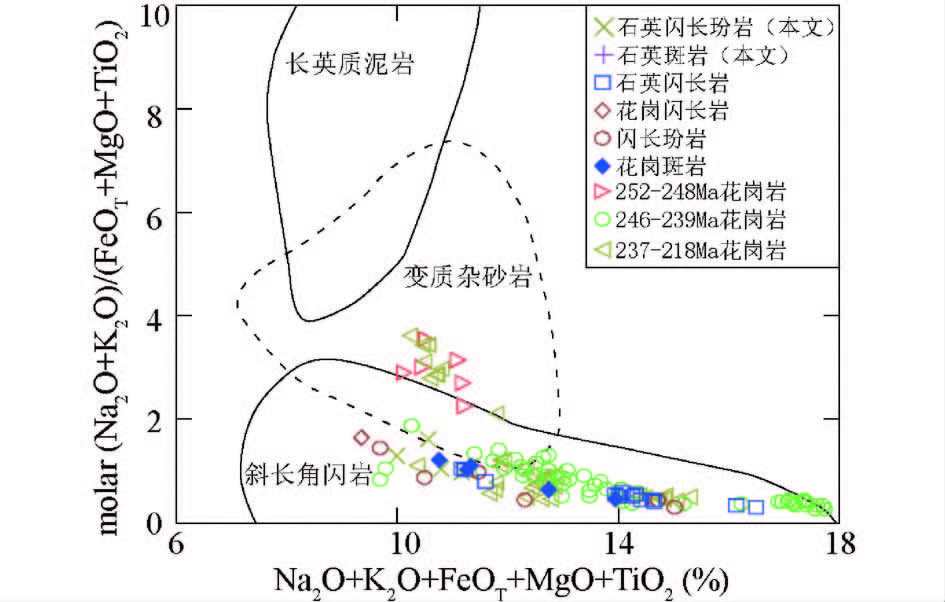
|
图 13 赛什塘矿区和西秦岭花岗质岩石地球化学成分与实验熔体化学成分(据Patiño Douce,1999)对比 Fig. 13 Comparison of geochemical compositions of the granitoids from the Saishitang Cu deposit and West Qinling with compositonal fields of some experimental melts(after Patiño Douce,1999) |
|
|
表 5 西秦岭三叠纪花岗岩同位素特征对比 Table 5 Comparison of isotopic characteristics of Triassic granitoids from West Qinling |
区域上,西秦岭242Ma安山岩和花岗闪长岩以及赛什塘矿区220Ma石英斑岩中含有少量前三叠纪(310~2320Ma,本文; Guo et al., 2012; 骆必继等,2012; 闫臻等,2012; Ren et al., 2016)继承性锆石,且部分继承性锆石具正εHf(t)值,分别为+2.9(310Ma)、+7.3(420Ma)、+10.3(450Ma)和+7.1~+11.6(451Ma),它们对应的二阶段模式年龄分别为1139Ma、944Ma、779Ma和695~980Ma(Guo et al., 2012),表明来源于中-新元古界地壳;其它继承性锆石εHf(t)为-7.4(454Ma)(本文)、-3.7(419Ma)和-17.4(777Ma)(Guo et al., 2012),二阶段模式年龄分别为1905Ma、1643Ma和2793Ma,显示其与更老的地壳物质有关。这些继承性锆石U-Pb年龄与西秦岭地区南侧三叠纪阿尼玛卿蛇绿混杂带中的早古生代、晚古生代两期蛇绿岩单元以及北侧早古生代岛弧钙碱性岩浆岩(Bian et al., 2004; 杨经绥等,2004; 边千韬等,2007; 李王晔等,2007; 刘战庆等, 2011a,b; 闫臻等,2012)时代相一致,暗示了西秦岭三叠纪花岗岩可能是由于古特提斯洋在三叠纪时期发生向北俯冲过程中,早期的增生杂岩发生重熔并成为三叠纪岩浆的重要来源。
5.3 构造背景西秦岭三叠纪岩浆作用及形成大地构造环境一直是学术界关注的焦点,究其主要原因是该地区已发现大量与其相关的斑岩-矽卡岩型矿床,同时这些岩浆作用的形成可为古特提斯洋的演化提供重要证据。
前人研究资料表明,西秦岭花岗质岩石主要类型有黑云母花岗岩、正长花岗岩、石英闪长岩、花岗闪长岩、闪长岩、花岗斑岩和石英斑岩等,这些花岗岩在空间上具有自北而南其形成时代逐渐变年轻特征(图 1b)。西秦岭252~248Ma花岗岩属于弱过铝质钾玄岩,246~218Ma花岗岩及赛什塘铜矿床花岗质岩石均属于准铝质和弱过铝质钙碱性-高钾钙碱性-钾玄岩系列(图 5),这些花岗岩富集Ba、Th等大离子亲石元素以及强烈亏损Nb、Ta、Zr和Ti等高场强元素(图 6; 孙延贵,2004; 金维浚等,2005; 张宏飞等,2006; 强娟,2008; Zhu et al., 2011; Guo et al., 2012; 刘建平等,2012; 闫臻等,2012; Luo et al., 2012,2015; 黄雄飞等,2013; Li et al., 2013,2014,2015; 韦萍等,2013; 徐学义等,2014; 李秀财等,2015; Yang et al., 2015; Ren et al., 2016; Wang et al., 2016; Xiong et al., 2016),呈现出典型岛弧岩浆岩地球化学特征(图 6)。在花岗岩构造环境判别图上(图 14),赛什塘铜矿床花岗质岩石和西秦岭252~218Ma花岗岩主体落入岛弧花岗岩范围。此外,研究区内隆务河群砂岩碎屑组成及其中丰富的安山岩、英安岩、流纹岩夹层共同表明,西秦岭下-中三叠统碎屑岩形成于活动大陆边缘(闫臻等, 2012,2014),其沉积物源区主要为其北侧南祁连构造带及东昆仑岩浆弧(Weislogel et al., 2006,2010; 陈岳龙等,2009; 闫臻等,2014)。空间上,研究区南侧的阿尼玛卿-勉略蛇绿混杂带最终形成于晚三叠世(Meng and Zhang, 1999; Bian et al., 2004; 杨经绥等,2004; 张国伟等,2004)。这些事实共同表明,赛什塘铜矿床花岗质岩石和西秦岭三叠纪花岗岩形成于活动大陆边缘,其形成与古特提斯洋俯冲作用密切相关。

|
图 14 赛什塘矿区和西秦岭花岗质岩石(Y+Nb)-Rb(a,据Pearce et al., 1984)和(Yb+Ta)-Rb(b,据Pearce et al., 1984)构造判别图解 Fig. 14 (Y+Nb)vs. Rb(a,after Pearce et al., 1984)and(Yb+Ta)vs. Rb(b,after Pearce et al., 1984)tectonic setting discrimination diagrams of the granitoids from the Saishitang Cu deposit and West Qinling |
(1) 赛什塘铜矿区花岗质岩石由闪长玢岩、石英闪长岩、石英闪长玢岩,花岗斑岩和石英斑岩共同组成,属于准铝质和弱过铝质钙碱性-高钾钙碱性系列,为I型花岗岩;
(2) 赛什塘铜矿床花岗质岩石富集Cs、Rb、K、Pb等大离子亲石元素,强烈亏损Nb、Ta、Zr和Ti等高场强元素,具有与岛弧花岗岩相似地球化学特征;
(3) SHRIMP锆石U-Pb测年结果表明,赛什塘铜矿区石英闪长玢岩和石英斑岩分别形成于219.0±2.3Ma和220.0±2.0Ma;
(4) 赛什塘铜矿区花岗质岩石源区物质为中元古界下地壳变基性岩类,岩浆形成过程中经历了部分熔融作用,并可能有少量幔源岩浆的加入,形成于古特提斯洋向北俯冲过程中。
致谢 北京离子探针中心杨淳、颉颃强副研究员在SHRIMP锆石U-Pb测年工作中给予了指导和帮助;本刊编辑和三位匿名评阅人对本文提出建设性修改意见;在此一并表示衷心感谢!
| [1] | Bian QT, Li DH, Pospelov I, Yin LM, Li HS, Zhao DS, Chang CF, Luo XQ, Gao SL, Astrakhantsev O and Chamov N. 2004. Age, geochemistry and tectonic setting of Buqingshan ophiolites, North Qinghai-Tibet Plateau, China. Journal of Asian Earth Sciences, 23(4): 577-596 |
| [2] | Bian QT, Pospelov Ⅱ, Li HM, Chang CF and Li JL. 2007. Discovery of the end-Early Paleozoic adakite in the Buqingshan area, Qinghai Province, and its tectonic implications. Acta Petrologica Sinica, 23(5): 925-934 (in Chinese with English abstract) |
| [3] | Blevin PL and Chappell BW. 1995. Chemistry, origin, and evolution of mineralized granites in the Lachlan fold belt, Australia: The metallogeny of I- and S-type granites. Economic Geology, 90(6): 1604-1619 |
| [4] | Blichert-Toft J and Albarède F. 1997. The Lu-Hf isotope geochemistry of chondrites and the evolution of the mantle-crust system. Earth and Planetary Science Letters, 148(1-2): 243-258 |
| [5] | Boztuğ D, Harlavan Y, Arehart GB, Satír M and Avcí N. 2007. K-Ar age, whole-rock and isotope geochemistry of A-type granitoids in the Divriği-Sivas region, eastern-central Anatolia, Turkey. Lithos, 97(1-2): 193-218 |
| [6] | Chappell BW and White AJR. 1992. I- and S-type granites in the Lachlan Fold Belt. In: Brown PE and Chappell BW (eds.). The Second Hutton Symposium on the Origin of Granites and Related Rocks. Edinburgh: Transactions of the Royal Society of Edinburgh, 83: 1-26 |
| [7] | Chen YL, Zhou J, Pi QH, Wang Z and Li DP. 2009. Zircon U-Pb dating and geochemistry of clastic sedimentary rocks in the Gonghe-Huashixia area, Qinghai Province and their geological implications. Earth Science Frontiers, 16(2): 161-174 (in Chinese with English abstract) |
| [8] | Dostal J and Chatterjee AK. 2000. Contrasting behaviour of Nb/Ta and Zr/Hf ratios in a peraluminous granitic pluton (Nova Scotia, Canada). Chemical Geology, 163(1-4): 207-218 |
| [9] | Fu XM, Dai TG, Xi CZ, Liu W and Liu X. 2010. Characteristics of ore-forming fluid and genesis of the Shuangpengxi gold-copper deposit in Qinghai Province. Contributions to Geology and Mineral Resources Research, 25(1): 24-29 (in Chinese with English abstract) |
| [10] | Griffin WL, Pearson NJ, Belousova E, Jackson SE, van Achterbergh E, O'Reilly SY and Shee SR. 2000. The Hf isotope composition of cratonic mantle: LAM-MC-ICPMS analysis of zircon megacrysts in kimberlites. Geochimica et Cosmochimica Acta, 64(1): 133-147 |
| [11] | Guo XQ, Yan Z, Wang ZQ, Wang T, Wu FF, Fu CL, Hou KJ and Li JL. 2011. Geological characteristics and associated magmatic ages of the Xiekeng skarn-type Cu-Au deposit in the West Qinling terrane. Acta Petrologica Sinica, 27(12): 3811-3822 (in Chinese with English abstract) |
| [12] | Guo XQ, Yan Z, Wang ZQ, Wang T, Hou KJ, Fu CL and Li JL. 2012. Middle Triassic arc magmatism along the northeastern margin of the Tibet: U-Pb and Lu-Hf zircon characterization of the Gangcha complex in the West Qinling terrane, central China. Journal of the Geological Society, 169(3): 327-336 |
| [13] | Hofmann AW. 1988. Chemical differentiation of the Earth: The relationship between mantle, continental crust, and oceanic crust. Earth and Planetary Science Letters, 90(3): 297-314 |
| [14] | Huang XF, Mo XX, Yu XH, Li XW, Ding Y, Wei P and He WY. 2013. Zircon U-Pb chronology, geochemistry of the Late Triassic acid volcanic rocks in Tanchang area, West Qinling and their geological significance. Acta Petrologica Sinica, 29(11): 3968-3980 (in Chinese with English abstract) |
| [15] | Jiang XS, Pan GT, Yan YJ and Li XZ. 1996. Triassic sedimentary framework and tectopaleogeographic evolution of the juncture of the Qinling, Qilian and Kunlun orogenic belts. Acta Geologica Sichuan, 16(3): 204-208 (in Chinese with English abstract) |
| [16] | Jin WJ, Zhang Q, He DF and Jia XQ. 2005. SHRIMP dating of adakites in western Qinling and their implications. Acta Petrologica Sinica, 21(3): 959-966 (in Chinese with English abstract) |
| [17] | Kemp AIS, Hawkesworth CJ, Foster GL, Paterson BA, Woodhead JD, Hergt JM, Gray CM and Whitehouse MJ. 2007. Magmatic and crustal differentiation history of granitic rocks from Hf-O isotopes in zircon. Science, 315(5814): 980-983 |
| [18] | Lai JQ, An JH, Wang XJ, Mao Y, Song ZY, Cao YH, Tao JJ, Guo ZJ and Wang J. 2010. Geochemical characteristics and tectonic environment analysis of the intrusive rocks in Saishitang ore field. Mineral Resources and Geology, 24(5): 460-465 (in Chinese with English abstract) |
| [19] | Li DS, Kui MJ, Gu FB, Wang JJ, Bai HX, Zhan FY, Wang FM and Ma YQ. 2009. Geological characteristics and genesis of the Saishitang copper deposit in Qinghai Province. Acta Geologica Sinica, 83(5): 719-730 (in Chinese with English abstract) |
| [20] | Li H, Xi XS, Wu CM, Zheng Y and Qing DC. 2010. Geological features and the metallogenic model of the W-Cu polymetallic deposit at Jiangligou in Tongren County, Qinghai Province. Geology and Exploration, 46(5): 872-879 (in Chinese with English abstract) |
| [21] | Li LG, Liu H, Yang ZX and Pan Q. 2012. Geological characteristics and deep prospecting evaluation in Saishitang copper deposit. Nonferrous Metals (Mining Section), 64(2): 39-42, 62 (in Chinese with English abstract) |
| [22] | Li WY, Li SG, Guo AL, Sun YG and Zhang GW. 2007. Zircon SHRIMP U-Pb ages and trace element geochemistry of the Kuhai gabbro and the Dur'ngoi diorite in the southern East Kunlun tectonic belt, Qinghai, western China and their geological implications. Science in China (Series D), 50(Suppl.2): 331-338 |
| [23] | Li XC, Niu ML, Wu Q, Fu CL, Guo XQ and Xie X. 2015. SHRIMP zircon U-Pb dating of andesite and its constraint on mineralization age in Xiabulang Cu-Pb-Zn deposit, Tongren County, Qinghai. Chinese Journal of Geology, 50(4): 1154-1165 (in Chinese with English abstract) |
| [24] | Li XW, Mo XX, Yu XH, Ding Y, Huang XF, Wei P and He WY. 2013. Petrology and geochemistry of the Early Mesozoic pyroxene andesites in the Maixiu area, West Qinling, China: Products of subduction or syn-collision? Lithos, 172-173: 158-174 |
| [25] | Li XW, Mo XX, Bader T, Scheltens M, Yu XH, Dong GC and Huang XF. 2014. Petrology, geochemistry and geochronology of the magmatic suite from the Jianzha Complex, central China: Petrogenesis and geodynamic implications. Journal of Asian Earth Sciences, 95: 164-181 |
| [26] | Li XW, Mo XX, Huang XF, Dong GC, Yu XH, Luo MF and Liu YB. 2015. U-Pb zircon geochronology, geochemical and Sr-Nd-Hf isotopic compositions of the Early Indosinian Tongren Pluton in West Qinling: Petrogenesis and geodynamic implications. Journal of Asian Earth Sciences, 97: 38-50 |
| [27] | Liu JP, Lai JQ, Gu XP, Wang XJ, Mao Y and Song WB. 2012. Geochemistry and zircon LA-ICPMS U-Pb geochronology of intrusive body in Saishitang copper deposit, Qinghai Province, China. The Chinese Journal of Nonferrous Metals, 22(3): 622-632 (in Chinese with English abstract) |
| [28] | Liu ZQ, Pei XZ, Li RB, Li ZC, Chen YX, Gao JM, Liu CJ, Wang XL, Wei FH, Zhang G and Yang ZZ. 2011a. Geological characteristics of the Buqingshan tectonic melange belt in the southern margin of east Kunlun and its tectonic implications. Geological Bulletin of China, 30(8): 1182-1195 (in Chinese with English abstract) |
| [29] | Liu ZQ, Pei XZ, Li RB, Li ZC, Zhang XF, Liu ZG, Chen GC, Chen YX, Ding SP and Guo JF. 2011b. LA-ICP-MS zircon U-Pb geochronology of the two suites of ophiolites at the Buqingshan area of the A'nyemaqen orogenic belt in the southern margin of east Kunlun and its tectonic implication. Acta Geologica Sinica, 85(2): 185-194 (in Chinese with English abstract) |
| [30] | Liu ZT, Ren JQ, Wu JR, Huang CH, Lu HQ, Wang HY, Zhang MF, Peng XG and Pang CL. 2008. Copper deposit in Qinghai Province. Beijing: Geological Publishing House, 1-291 (in Chinese) |
| [31] | Lu YC, Liu JJ, Zhang D, Carranza EJM, Zhai DG, Ge LS, Sun H, Wang B, Chen YF and Liu P. 2016. Genesis of the Saishitang skarn type copper deposit, West Qinling, Qinghai Province: Evidence from fluid inclusions and stable isotopes. Ore Geology Reviews, 75: 268-283 |
| [32] | Ludwig KR. 2003. ISOPLOT 3.0: A geochronological Toolkit for Microsoft Excel. Berkeley: Berkeley Geochronology Center Special publication, 4: 1-70 |
| [33] | Luo BJ, Zhang HF and Lü XB. 2012. U-Pb zircon dating, geochemical and Sr-Nd-Hf isotopic compositions of Early Indosinian intrusive rocks in West Qinling, central China: Petrogenesis and tectonic implications. Contributions to Mineralogy and Petrology, 164(4): 551-569 |
| [34] | Luo BJ, Zhang HF and Xiao ZQ. 2012. Petrogenesis and tectonic implications of the Early Indosinian Meiwu pluton in West Qinling, central China. Earth Science Frontiers, 19(3): 199-213 (in Chinese with English abstract) |
| [35] | Luo BJ, Zhang HF, Xu WC, Guo L, Pan FB and Yang H. 2015. The Middle Triassic Meiwu batholith, West Qinling, Central China: Implications for the evolution of compositional diversity in a composite batholith. Journal of Petrology, 56(6): 1139-1172 |
| [36] | Maniar PD and Piccoli PM. 1989. Tectonic discrimination of granitoids. Geological Society of America Bulletin, 101(5): 635-643 |
| [37] | Meng QR and Zhang GW. 1999. Timing of collision of the North and South China blocks: Controversy and reconciliation. Geology, 27(2): 123-126 |
| [38] | Pan GT, Chen ZL, Li XZ, Yan YJ, Xu XS, Xu Q, Jiang XS, Wu YL, Luo JN, Zhu TX and Peng YM. 1997. Geological-Tectonic Evolution in the Eastern Tethys. Beijing: Geological Publishing House, 1-218 (in Chinese) |
| [39] | Patiño Douce AE. 1999. What do experiments tell us about the relative contributions of crust and mantle to the origin of granitic magmas? In: Castro A, Fernandez C and Vigneresse JL (eds.). Understanding Granites: Intergrating New and Classical Techniques. Geological Society, London, Special Publications, 168: 55-75 |
| [40] | Pearce JA, Harris NBW and Tindle AG. 1984. Trace element discrimination diagrams for the tectonic interpretation of granitic rocks. Journal of Petrology, 25(4): 956-983 |
| [41] | Qiang J. 2008. The granitoids in Zongwulong tectonic zone on the northeastern margin of the Qinghai-Tibet Plateau and its tectonic significance. Master Degree Thesis. Xi'an: Northwest University, 1-76 (in Chinese with English summary) |
| [42] | Qiu FQ and Dong JS. 1978. The characteristics of magmatite and mineralization in Saishitang Cu deposit, Qinghai Province. Qinghai Geology, (3): 1-19 (in Chinese) |
| [43] | Rapp RP and Watson EB. 1995. Dehydration melting of metabasalt at 8-32kbar: Implications for continental growth and crust-mantle recycling. Journal of Petrology, 36(4): 891-931 |
| [44] | Ren HD, Wang T, Zhang L, Wang XX, Huang H, Feng CY, Teschner C and Song P. 2016. Ages, sources and tectonic settings of the Triassic igneous rocks in the easternmost segment of the East Kunlun Orogen, Central China. Acta Geologica Sinica, 90(2): 641-668 |
| [45] | Rickwood PC. 1989. Boundary lines within petrologic diagrams which use oxides of major and minor elements. Lithos, 22(4): 247-263 |
| [46] | Schiano P, Monzier M, Eissen JP, Martin H and Koga KT. 2010. Simple mixing as the major control of the evolution of volcanic suites in the Ecuadorian Andes. Contributions to Mineralogy and Petrology, 160(2): 297-312 |
| [47] | Schmidberger SS and Hegner E. 1999. Geochemistry and isotope systematics of calc-alkaline volcanic rocks from the Saar-Nahe basin (SW Germany): Implications for Late-Variscan orogenic development. Contributions to Mineralogy and Petrology, 135(4): 373-385 |
| [48] | Smithies RH and Champion DC. 2000. The Archaean high-Mg diorite suite: Links to tonalite-trondhjemite-granodiorite magmatism and implications for Early Archaean crustal growth. Journal of Petrology, 41(12): 1653-1671 |
| [49] | Song B, Zhang YH, Wan YS and Jian P. 2002. Mount making and procedure of the SHRIMP dating. Geological Review, 48(Suppl.): 26-30 (in Chinese with English abstract) |
| [50] | Song ZJ, Zhang HW, Li WM, Zhang XG and Wang W. 1995. Metallogenic conditions and model of copper-multi-metal deposits in Ngolashan region, Qinghai Province. Northwest Geoscience, 16(1): 134-144 (in Chinese with English abstract) |
| [51] | Sun SS and Mcdonough WF. 1989. Chemical and isotopic systematics of oceanic basalts: Implications for mantle composition and processes. In: Saunders AD and Norry MJ (eds.). Magmatism in the Ocean Basins. Geological Society, London, Special Publications, 42(1): 313-345 |
| [52] | Sun YG. 2004. Gonghe aulacogen and conjugate and transfer between the West Qinling and East Kunlun orogens. Ph. D. Dissertation. Xi'an: Northwest Univiersity, 1-195 (in Chinese with English summary) |
| [53] | Tian SY. 1999. Relations between magmatic rocks and metallization of the Saishitang-Rilonggou ore field in Qinghai. Geological Exploration for Non-ferrous Metals, 8(6): 383-387 (in Chinese with English abstract) |
| [54] | Vervoort JD, Patchett PJ, Gehrels GE and Nutman AP. 1996. Constraints on early Earth differentiation from hafnium and neodymium isotopes. Nature, 379(6566): 624-627 |
| [55] | Wang H, Feng CY, Li DX, Ding TZ, Wang HQ, Liu JN and Zhou JH. 2015. Mineralogical characteristics and geological significance of skarn in the Saishitang copper deposit, Xinghai County, Qinghai Province. Acta Geoscientica Sinica, 36(3): 313-322 (in Chinese with English abstract) |
| [56] | Wang H, Feng CY, Li DX, Li C, Ding TZ and Liao FZ. 2016. Geology, geochronology and geochemistry of the Saishitang Cu deposit, East Kunlun Mountains, NW China: Constraints on ore genesis and tectonic setting. Ore Geology Reviews, 72: 43-59 |
| [57] | Wang JS and Wang YW. 2015. Metallogenic geological characteristics and enrichment regularity of the Saishitang copper deposit, Qinghai. Mineral Exploration, 6(3): 224-231 (in Chinese with English abstract) |
| [58] | Wei P, Mo XX, Yu XH, Huang XF, Ding Y and Li XW. 2013. Geochemistry, chronology and geological significance of the granitoids in Xiahe, West Qinling. Acta Petrologica Sinica, 29(11): 3981-3992 (in Chinese with English abstract) |
| [59] | Weislogel AL, Graham SA, Chang EZ, Wooden JL, Gehrels GE and Yang HS. 2006. Detrital zircon provenance of the Late Triassic Songpan-Ganzi complex: Sedimentary record of collision of the North and South China blocks. Geology, 34(2): 97-100 |
| [60] | Weislogel AL, Graham SA, Chang EZ, Wooden JL and Gehrels GE. 2010. Detrital zircon provenance from three turbidite depocenters of the Middle-Upper Triassic Songpan-Ganzi complex, central China: Record of collisional tectonics, erosional exhumation, and sediment production. Geological Society of America Bulletin, 122(11-12): 2041-2062 |
| [61] | Wu FY, Yang YH, Xie LW, Yang JH and Xu P. 2006. Hf isotopic compositions of the standard zircons and baddeleyites used in U-Pb geochronology. Chemical Geology, 234(1-2): 105-126 |
| [62] | Wu ZN, Ji WH, He SP, Chen SJ, Yu PS, Shi C, Chen FN, Zhang HS and Peng Y. 2015. LA-ICP-MS zircon U-Pb dating and geochemical characteristics of granodiorite in Rilonggou area, Xinghai County, Qinghai Province. Geological Bulletin of China, 34(9): 1677-1688 (in Chinese with English abstract) |
| [63] | Xiong X, Zhu LM, Zhang GW, Li B, Qi L, Stevenson D, Yang T, Wang F, Zheng J, Jiang H and Guo AL. 2016. Geology and geochemistry of the Triassic Wenquan Mo deposit and Mo-mineralized granite in the western Qinling Orogen, China. Gondwana Research, 30: 159-178 |
| [64] | Xu XY, Chen JL, Gao T, Li P and Li T. 2014. Granitoid magmatism and tectonic evolution in northern edge of the western Qinling terrane, NW China. Acta Petrologica Sinica, 30(2): 371-389 (in Chinese with English abstract) |
| [65] | Yan JP, Zhang WH, Zhang YC, Jin BY and Yuan SS. 2011. Metallogenic conditions and prospecting potential of Jiawu gold belt, Qinghai Province. Gold Science and Technology, 19(2): 35-40 (in Chinese with English abstract) |
| [66] | Yan Z, Wang ZQ, Li JL, Xu ZQ and Deng JF. 2012. Tectonic settings and accretionary orogenesis of the West Qinling Terrane, northeastern margin of the Tibet Plateau. Acta Petrologica Sinica, 28(6): 1808-1828 (in Chinese with English abstract) |
| [67] | Yan Z, Wang ZQ, Chen L, Liu SW, Ren T, Xu XX and Wang RT. 2014. Tectono-magmatism and metallogeneses of Shanyang-Zhashui ore concentration area in Qinling Orogen. Acta Petrologica Sinica, 30(2): 401-414 (in Chinese with English abstract) |
| [68] | Yang GX, Yang SH, Wei LY, Li ZC, Li RB, Xu DX and Liu MN. 2015. Petrogenesis and geodynamic significance of the Late Triassic Tadong adakitic pluton in West Qinling, central China. International Geology Review, 57(13): 1755-1771 |
| [69] | Yang JS, Wang XB, Shi RD, Xu ZQ and Wu CL. 2004. The Dur'ngoi ophiolite in East Kunlun, northern Qinghai-Tibet Plateau: A fragment of paleo-Tethyan oceanic crust. Geology in China, 31(3): 225-239 (in Chinese with English abstract) |
| [70] | Zeng FJ, Li DB and Tao YL. 2009. The geological character and ore-seeking prospect analysis on Walegen gold mine in Zeku County, Qinghai. Journal of Qinghai University (Nature Science), 27(5): 7-13 (in Chinese with English abstract) |
| [71] | Zeng XH and Zhou ZG. 2014. Geochemistry constraint on ore-forming material and ore-forming fluids of Tongyugou copper deposit in Xinghai County, Qinghai Province. Geoscience, 28(2): 348-358 (in Chinese with English abstract) |
| [72] | Zhan FY, Gu FB, Li DS, Cao LQ and Kui MJ. 2007. Tectonic environment of adakite in eastern Kunlun area, Qinghai, and its ore-forming significance. Acta Geologica Sinica, 81(10): 1352-1368 (in Chinese with English abstract) |
| [73] | Zhang GW, Guo AL and Yao AP. 2004. Western Qinling-Songpan continental tectonic node in China's continental tectonics. Earth Science Frontiers, 11(3): 23-32 (in Chinese with English abstract) |
| [74] | Zhang HF, Chen YL, Xu WC, Liu R, Yuan HL and Liu XM. 2006. Granitoids around Gonghe basin in Qinghai Province: Petrogenesis and tectonic implications. Acta Petrologica Sinica, 22(12): 2910-2922 (in Chinese with English abstract) |
| [75] | Zhang HF, Jin LL, Zhang L, Harris N, Zhou L, Hu SH and Zhang BR. 2007. Geochemical and Pb-Sr-Nd isotopic compositions of granitoids from western Qinling belt: Constraints on basement nature and tectonic affinity. Science in China (Series D), 50(2): 184-196 |
| [76] | Zhang ZY, Ding TZ, He P and Zhu XY. 2014. Characteristics of superposed folds and its tectonic significance in Saishitang ore district, Qinghai Province: Tectonic study on a superposed fold zone. Northwestern Geology, 47(2): 1-10 (in Chinese with English abstract) |
| [77] | Zhu LM, Zhang GW, Chen YJ, Ding ZJ, Guo B, Wang F and Lee B. 2011. Zircon U-Pb ages and geochemistry of the Wenquan Mo-bearing granitioids in West Qinling, China: Constraints on the geodynamic setting for the newly discovered Wenquan Mo deposit. Ore Geology Reviews, 39(1-2): 46-62 |
| [78] | 边千韬, Pospelov II, 李惠民, 常承法, 李继亮. 2007. 青海省布青山早古生代末期埃达克岩的发现及其构造意义. 岩石学报, 23(5): 925-934 |
| [79] | 陈岳龙, 周建, 皮桥辉, 王忠, 李大鹏. 2009. 青海共和-花石峡三叠纪碎屑沉积岩的地球化学特征与锆石U-Pb年龄及地质意义. 地学前缘, 16(2): 161-174 |
| [80] | 傅晓明, 戴塔根, 息朝庄, 刘伟, 刘旭. 2010. 青海双朋西金铜矿床的成矿流体特征及流体来源. 地质找矿论丛, 25(1): 24-29 |
| [81] | 郭现轻, 闫臻, 王宗起, 王涛, 吴发富, 付长垒, 候可军, 李继亮. 2011. 西秦岭谢坑矽卡岩型铜金矿床地质特征与矿区岩浆岩年代学研究. 岩石学报, 27(12): 3811-3822 |
| [82] | 黄雄飞, 莫宣学, 喻学惠, 李小伟, 丁一, 韦萍, 和文言. 2013. 西秦岭宕昌地区晚三叠世酸性火山岩的锆石U-Pb年代学、地球化学及其地质意义. 岩石学报, 29(11): 3968-3980 |
| [83] | 江新胜, 潘桂棠, 颜仰基, 李兴振. 1996. 秦、祁、昆交接区三叠纪沉积相格架及构造古地理演化. 四川地质学报, 16(3): 204-208 |
| [84] | 金维浚, 张旗, 何登发, 贾秀勤. 2005. 西秦岭埃达克岩的SHRIMP定年及其构造意义. 岩石学报, 21(3): 959-966 |
| [85] | 赖健清, 安江华, 王雄军, 毛寅, 宋泽友, 曹勇华, 陶斤金, 郭志军, 王晶. 2010. 赛什塘矿区侵入岩的地球化学特征及构造环境分析. 矿产与地质, 24(5): 460-465 |
| [86] | 李东生, 奎明娟, 古凤宝, 王建军, 柏红喜, 詹发余, 王发明, 马彦青. 2009. 青海赛什塘铜矿床的地质特征及成因探讨. 地质学报, 83(5): 719-730 |
| [87] | 李欢, 奚小双, 吴城明, 郑宇, 卿得成. 2010. 青海同仁县江里沟钨-铜多金属矿床地质特征和成矿模式. 地质与勘探, 46(5): 872-879 |
| [88] | 李领贵, 刘恒, 阳正熙, 潘倩. 2012. 赛什塘铜矿床地质特征及深部找矿远景评价. 有色金属(矿山部分), 64(2): 39-42, 62 |
| [89] | 李王晔, 李曙光, 郭安林, 孙延贵, 张国伟. 2007. 青海东昆南构造带苦海辉长岩和德尔尼闪长岩的锆石SHRIMP U-Pb年龄及痕量元素地球化学-对"祁-柴-昆"晚新元古代-早奥陶世多岛洋南界的制约. 中国科学(D辑), 37(S): 288-294 |
| [90] | 李秀财, 牛漫兰, 吴齐, 付长磊, 郭现轻, 谢星. 2015. 青海省同仁县夏布浪铜铅锌矿床安山岩SHRIMP锆石U-Pb定年及其对成矿时代的制约. 地质科学, 50(4): 1154-1165 |
| [91] | 刘建平, 赖健清, 谷湘平, 王雄军, 毛寅, 宋文彬. 2012. 青海赛什塘铜矿区侵入岩体地球化学及锆石LA-ICPMS U-Pb年代学. 中国有色金属学报, 22(3): 622-632 |
| [92] | 刘战庆, 裴先治, 李瑞保, 李佐臣, 陈有炘, 高景民, 刘成军, 王学良, 魏方辉, 张刚, 杨忠智. 2011a. 东昆仑南缘布青山构造混杂岩带的地质特征及大地构造意义. 地质通报, 30(8): 1182-1195 |
| [93] | 刘战庆, 裴先治, 李瑞保, 李佐臣, 张晓飞, 刘智刚, 陈国超, 陈有炘, 丁仨平, 郭俊锋. 2011b. 东昆仑南缘阿尼玛卿构造带布青山地区两期蛇绿岩的LA-ICP-MS锆石U-Pb定年及其构造意义. 地质学报, 85(2): 185-194 |
| [94] | 刘增铁, 任家琪, 邬介人, 黄朝晖, 陆海青, 王红英, 张梅芬, 彭兴国, 庞存廉. 2008. 青海铜矿. 北京: 地质出版社, 1-291 |
| [95] | 骆必继, 张宏飞, 肖尊奇. 2012. 西秦岭印支早期美武岩体的岩石成因及其构造意义. 地学前缘, 19(3): 199-213 |
| [96] | 潘桂棠, 陈智梁, 李兴振, 颜仰基, 许效松, 徐强, 江新胜, 吴应林, 罗建宁, 朱同兴, 彭勇民. 1997. 东特提斯地质构造形成演化. 北京: 地质出版社, 1-218 |
| [97] | 强娟. 2008. 青藏高原东北缘宗务隆构造带花岗岩及其构造意义. 硕士学位论文. 西安: 西北大学, 1-76 |
| [98] | 邱风歧, 董景深. 1978. 青海赛什塘铜矿区岩浆岩及其成矿特征. 青海地质, (3): 1-19 |
| [99] | 宋彪, 张玉海, 万渝生, 简平. 2002. 锆石SHRIMP样品靶制作、年龄测定及有关现象讨论. 地质论评, 48(S): 26-30 |
| [100] | 宋治杰, 张汉文, 李文明, 张心广, 王维. 1995. 青海鄂拉山地区铜多金属矿床的成矿条件及成矿模式. 西北地质科学, 16(1): 134-144 |
| [101] | 孙延贵. 2004. 西秦岭-东昆仑造山带的衔接转换与共和坳拉谷. 博士学位论文. 西安: 西北大学, 1-195 |
| [102] | 田生玉. 1999. 青海赛什塘-日龙沟矿田岩浆岩与成矿的关系探讨. 有色金属矿产与勘查, 8(6): 383-387 |
| [103] | 王辉, 丰成友, 李大新, 丁天柱, 王洪庆, 刘建楠, 周建厚. 2015. 青海省兴海县赛什塘铜矿床矽卡岩矿物学特征及地质意义. 地球学报, 36(3): 313-322 |
| [104] | 王军升, 王玉往. 2015. 青海赛什塘铜矿成矿地质特征及矿床富集规律. 矿产勘查, 6(3): 224-231 |
| [105] | 韦萍, 莫宣学, 喻学惠, 黄雄飞, 丁一, 李小伟. 2013. 西秦岭夏河花岗岩的地球化学、年代学及地质意义. 岩石学报, 29(11): 3981-3992 |
| [106] | 吴中楠, 计文化, 何世平, 陈守建, 于浦生, 时超, 陈奋宁, 张辉善, 彭岩. 2015. 青海省兴海县日龙沟花岗闪长岩LA-ICP-MS锆石U-Pb年龄及地球化学特征. 地质通报, 34(9): 1677-1688 |
| [107] | 徐学义, 陈隽璐, 高婷, 李平, 李婷. 2014. 西秦岭北缘花岗质岩浆作用及构造演化. 岩石学报, 30(2): 371-389 |
| [108] | 闫家盼, 张文华, 张艳春, 金宝义, 袁士松. 2011. 青海加吾金矿带成矿条件及找矿远景浅析. 黄金科学技术, 19(2): 35-40 |
| [109] | 闫臻, 王宗起, 李继亮, 许志琴, 邓晋福. 2012. 西秦岭楔的构造属性及其增生造山过程. 岩石学报, 28(6): 1808-1828 |
| [110] | 闫臻, 王宗起, 陈雷, 刘树文, 任涛, 徐学义, 王瑞廷. 2014. 南秦岭山阳-柞水矿集区构造-岩浆-成矿作用. 岩石学报, 30(2): 401-414 |
| [111] | 杨经绥, 王希斌, 史仁灯, 许志琴, 吴才来. 2004. 青藏高原北部东昆仑南缘德尔尼蛇绿岩: 一个被肢解了的古特提斯洋壳. 中国地质, 31(3): 225-239 |
| [112] | 曾福基, 李德彪, 陶延林. 2009. 青海省泽库县瓦勒根金矿床地质特征及找矿前景分析. 青海大学学报(自然科学版), 27(5): 7-13 |
| [113] | 曾小华, 周宗桂. 2014. 青海省兴海县铜峪沟铜矿床成矿物质和流体来源的地球化学探讨. 现代地质, 28(2): 348-358 |
| [114] | 詹发余, 古凤宝, 李东生, 曹连强, 奎明娟. 2007. 青海东昆仑埃达克岩的构造环境及成矿意义. 地质学报, 81(10): 1352-1368 |
| [115] | 张国伟, 郭安林, 姚安平. 2004. 中国大陆构造中的西秦岭-松潘大陆构造结. 地学前缘, 11(3): 23-32 |
| [116] | 张宏飞, 陈岳龙, 徐旺春, 刘荣, 袁洪林, 柳小明. 2006. 青海共和盆地周缘印支期花岗岩类的成因及其构造意义. 岩石学报, 22(12): 2910-2922 |
| [117] | 张忠义, 丁天柱, 何鹏, 祝新友. 2014. 青海赛什塘矿区叠加褶皱特征及其构造意义——叠加褶皱区的矿区构造研究. 西北地质, 47(2): 1-10 |
 2016, Vol. 32
2016, Vol. 32


